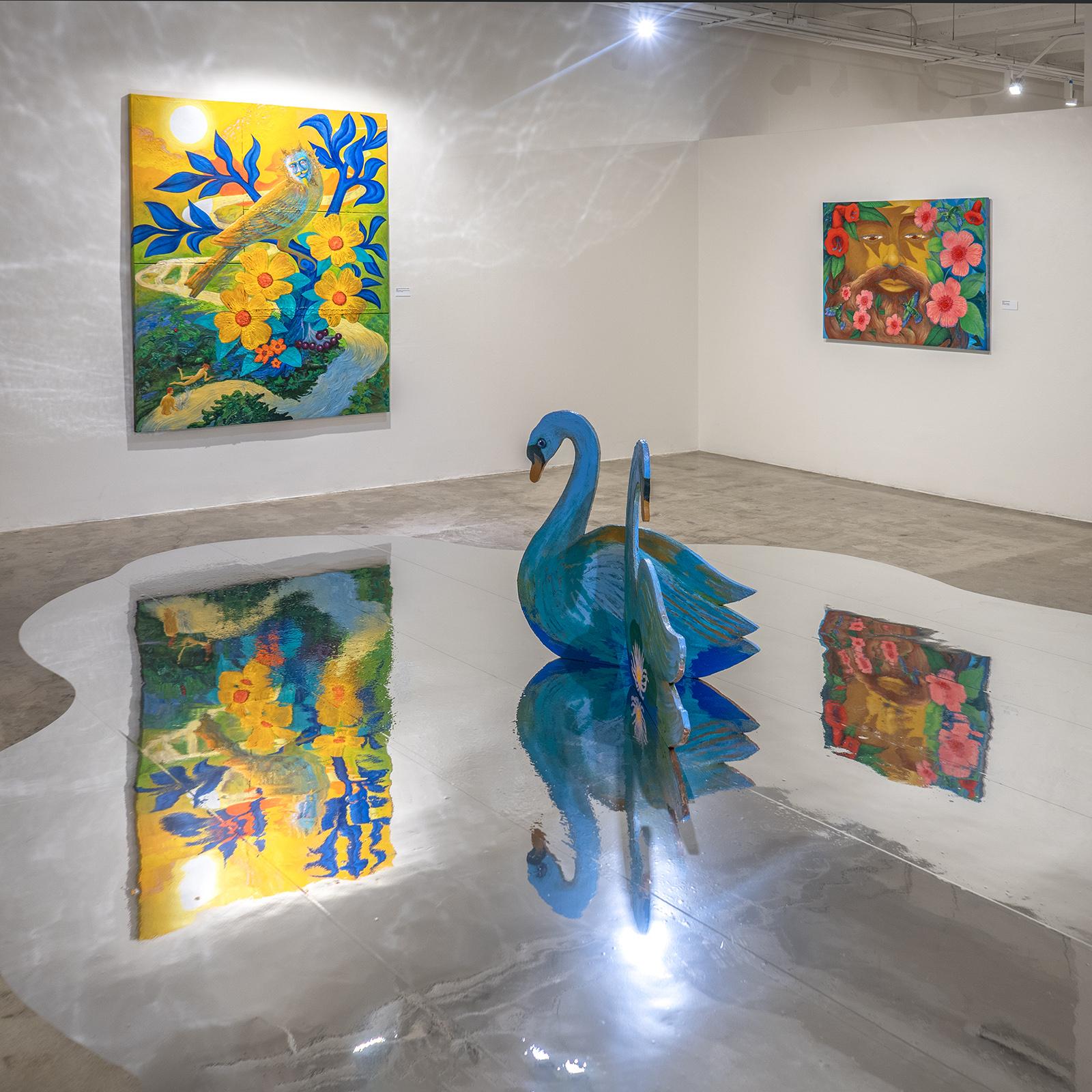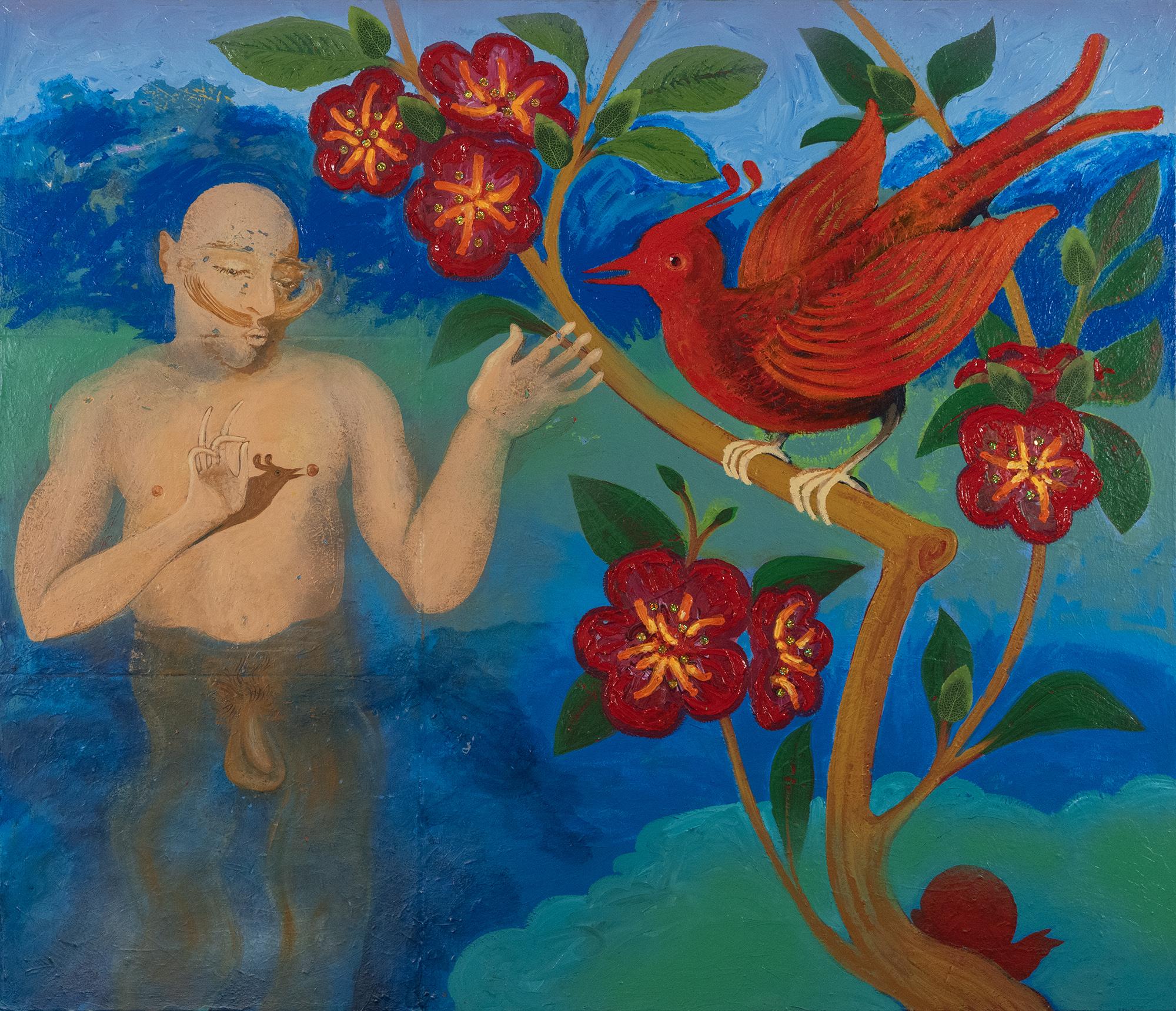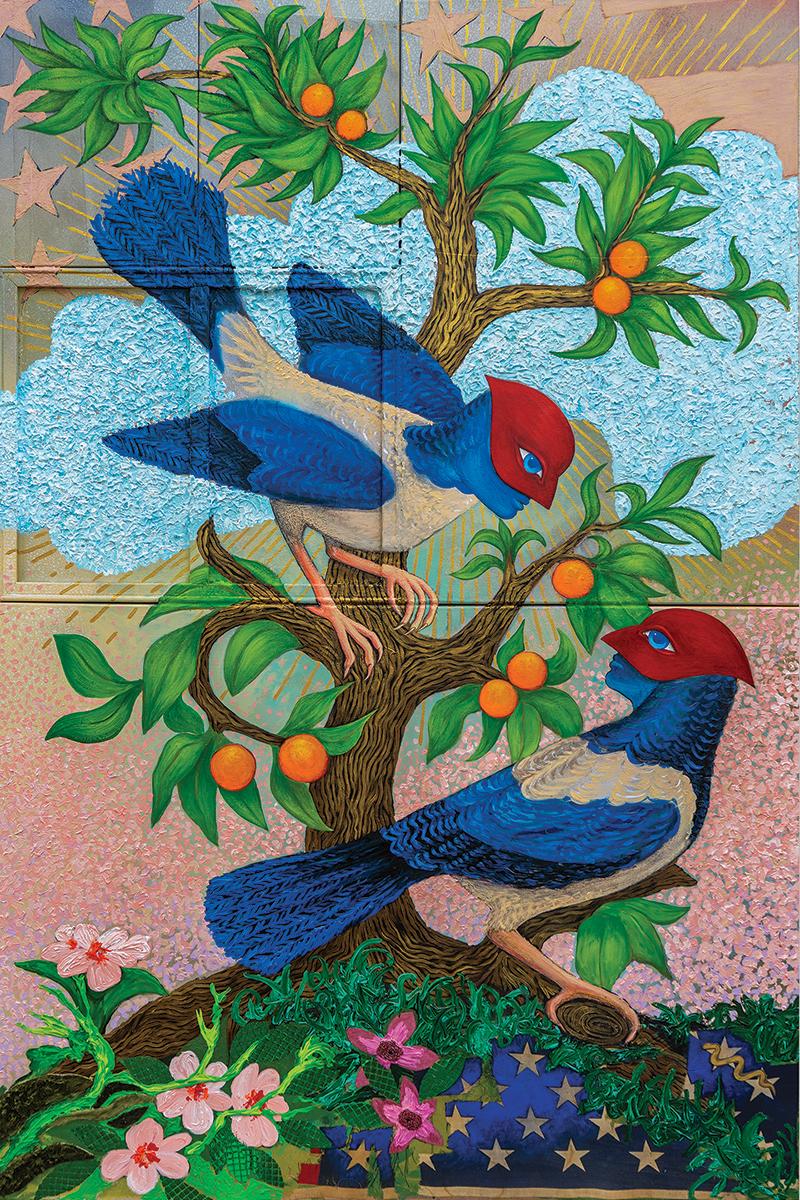In Dialogue

Vojislav Radovanović’s multidisciplinary practice spans painting, drawing, installation, video, and performance. His work touches upon themes of queerness, memory, the immigrant experience, spirituality, and the complex relationship between humans and the natural world. Influenced by his upbringing in Serbia during a time of war and social upheaval, Radovanović approaches art as a therapeutic space for healing and transformation. His process-driven works often combine recycled materials, vibrant color, and symbolic imagery to create poetic, emotionally resonant narratives. Through layered compositions and dreamlike logic, he invites viewers into a shared space of reflection, imagination, and emotional release.
I recently visited your exhibition, Bird Circuit, at the Silverman Gallery at CSLA. It was a striking show spanning painting, sculpture, and video installation. Can you tell us a bit about how the exhibition came together?
Thank you so much for visiting the exhibition and for your kind words. Bird Circuit came together thanks to an invitation from Dr. Mika M. Cho, the director of the Ronald H. Silverman Fine Arts Gallery. Mika has followed my work for several years and has been a strong supporter, visiting my studio multiple times. A few years ago, she, Jason Jenn (my partner and art collaborator), and I co-curated a group exhibition at the same gallery titled Memories of Tomorrow’s Sunrise, which explored themes of identity, inherited trauma, and chosen family. That collaboration was very meaningful to us, and we always hoped to work together again.
When Mika revisited my studio last year, she proposed a solo exhibition of my work curated by Jason. It felt like the perfect moment. I had been developing a body of work over the past three years that had not yet been exhibited, paintings, sculptures, and installations exploring queerness, coded language, and myth-making. The gallery’s annual programming theme around identity, self-understanding, and healing aligned beautifully with what I was trying to express.
From there, Jason and I began shaping the exhibition conceptually. Drawing inspiration from historical queer spaces, specifically mid-century bars with bird-themed names known as the “Bird Circuit”, we began weaving together personal, symbolic, and historical threads. Birds have long been central to my visual language, and in this show they became metaphors for queer resilience, coded communication, and fantastical transformation.

You have a unique personal history that seems to shape both your perspective on art and the work itself. Would you be open to sharing a bit about that background?
Absolutely. I was born in 1982 in the former Yugoslavia, in what is now Serbia, and I came of age during a time of political unrest, war, and social upheaval in the Balkans. That experience left a deep imprint on me, not only in terms of lived trauma, but also in the way I process the world through making art. Art became my sanctuary from a very young age, a private, intuitive space where I could feel safe and free.
Growing up queer in a conservative environment shaped my inner world profoundly. So much of my work now is about navigating between beauty and pain, personal and collective healing. Through painting and mixed media, I try to reassemble fragments of my memory into new, sometimes surreal narratives that speak to both personal truth and universal themes like identity, spirituality, and resilience.
Moving to Los Angeles in 2017 was a transformative chapter. It allowed me to access a broader, more expressive queer community and gave me the freedom to explore new materials, formats, and themes. Living and working in Southern California has not only expanded the scope of my practice, but also deepened my commitment to art as a tool for healing and cultural reflection.
You mentioned that after moving to California, you began using color more freely in your work. Can you talk about how the new environment influenced your palette or visual language?
I’ve always had a deep emotional connection to color, even as a very young child, I would spend hours painting with watercolors and tempera. Color was intuitive for me. But as I grew into my puberty, and an adult age, I found myself increasingly drawn to a black-and-white or muted palette, often using graphite. Part of that came from a love of drawing and the intimacy of working with just paper and ink or graphite. But I also think it was shaped by a cultural sensibility in Serbia, there’s often an unspoken belief that “serious” art must be subdued. If something is too colorful or “pretty,” it can be dismissed as superficial or decorative.
When I moved to California in 2017, something began to shift. The light here is so different, vibrant, expansive, and alive. The landscapes, the colors in nature, the visual language of Los Angeles, it all encouraged me to break free from that internalized restraint. I gave myself permission to embrace exuberance, brightness, and bold combinations. I started to see color not as a distraction from meaning, but as a carrier of it, as emotional, symbolic, and even political. Especially within queer culture, color has a powerful role in signaling identity and visibility. That expanded my palette both literally and metaphorically, and it’s now one of the most vital aspects of my practice.

While the curatorial text of Bird Circuit references weighty themes—trauma, ecology, identity—much of the work feels gentle, joyful, and materially indulgent. How do you navigate the tension between big ideas and the tactile pleasure of making?
That’s such a thoughtful observation, and it really gets to the heart of how I approach my work. For me, the process of making art is everything. I honestly don’t begin with the intention to create a finished product that communicates a specific concept. I start because I need to, because it helps me think, process, heal, and simply exist. Making art has always been my therapy, my safest place, and my most instinctive way of navigating the world.
Even when I’m dealing with heavy subjects, like trauma, loss, or cultural displacement, I don’t treat them with a sense of obligation or illustrate them in a didactic way. I let them move through me as I work, and the materials respond. The pleasure of layering paint, stitching fragments together, recycling older canvases, all of that is a way of grounding myself and transforming difficult experiences into something joyful and open-ended. The “indulgence” you mention is part of the alchemy: color, texture, glitter, fabric, odd materials… These things aren’t frivolous. They’re part of reclaiming beauty and playfulness as a form of resilience.
Meaning doesn’t lead the process, it follows. I often don’t know what a work is about until much later, and even then, I prefer to leave it open to interpretation. I believe the viewer brings their own experiences and imagination to the encounter. What matters most to me is the act of creation itself, that tactile, spiritual, messy, and healing journey that happens in the studio. That’s the real reward.
Many of your pieces balance a perfectionist attention to detail with the use of rough or recycled materials—handled in a way that feels light, almost improvisational. What does the life cycle of these works look like, from inception to completion?
Each piece really has its own path — there’s no fixed formula in my practice. I like to think of my methodology as an open process, where I allow the work to tell me what it wants to become. Sometimes I’ll begin with an abstract composition, working loosely with color, texture, and gesture, and then, over time, a landscape starts to appear, and eventually figures emerge from within it. Other times I begin with a very clear image, like an old toy, a porcelain figurine, or a symbolic object that reminds me of a person or a specific memory. Occasionally, it all starts from a dream or even just a feeling that I need to follow.
The materials themselves are collaborators in that process. I often repurpose older works, cutting them apart, collaging them into new canvases, stitching pieces together, or even carving into the layers of paint. That part of the process feels raw and tactile, but it’s never careless — even though it is very spontaneous, there’s a lot of emotions coming out. It’s a kind of physical improvisation that allows the work to shift and breathe over time.
The most healing moments often come when the portraits begin to take shape, not always literal portraits, but faces, characters, beings that emerge from the chaos of the surface. That’s when something clicks for me emotionally, and I start to feel like I’m in conversation with the piece. There’s something very personal, almost sacred, about that moment of recognition. From there, the painting guides me toward its final form, but it’s never about perfection. It’s about resonance.

An artist-to-artist question: can I get a peek into your studio brain? What does a typical studio day look like for you? Do you sketch or write? Do you listen to anything while working?
I try to keep a daily studio practice, even if I’m not actively painting, I make a point to go into the studio, sit with the work, and just be in the space. Some days I’m fully immersed for hours, and other times it’s just five quiet minutes of acknowledging what’s there, the unfinished, the almost finished, or the ones I’ve tucked away for a while because they needed to rest, or I needed to.
I always have at least three paintings going at once. I move between them intuitively, depending on what feels active or what needs attention. Some paintings I’ve worked on for years, not continuously, but in cycles. I’m a fast painter in terms of gesture and paint application, but each painting goes through many sessions and emotional stages. Sometimes I work intensely on a piece and then hide it from myself for months until I’m ready to see it again. I’ve learned that time is a material, too.
Honestly, many of my paintings require more time to look at than they take to paint. Observation is a big part of my studio rhythm, I sit, I stare, I read what’s happening in the composition, textures or colors, and let the next move come naturally.
Music is always playing. My soundtrack shifts with my mood and the stage of the painting. Sometimes it’s jazz, something with flow and unpredictability. Other times it’s psychedelic funk, or classical music. And then, suddenly, Lana Del Rey will come on and it just fits. I let the music guide the energy in the room. It’s all part of the atmosphere that holds the work.
There’s often a poetic, subtly surreal humor in your work. What role does humor play in your practice?
That’s such a beautiful question, and I’m glad you noticed that thread in the work. Humor isn’t something I plan or intentionally insert to lighten the mood. It usually arrives on its own, almost like a byproduct of being fully present in the studio. It’s an organic reaction to the process, the tension, the absurdity, the frustration, the wonder, all of it mixed together.
Often I’ll be deep in a painting, dealing with serious or emotionally complex themes, and then suddenly a little detail appears, a gesture that just feels right. It’s not about making a joke, but about honoring the complexity of the moment. Humor can be disarming. It can open a door that lets the viewer walk in, and once inside, they might discover deeper layers beneath the surface.
In that way, it’s almost like surrealism, not in the strict art historical sense, but in the sense that the logic of the painting follows emotional or dream logic. Humor often thrives in those spaces. It comes from contrast, from friction, from things that shouldn’t go together but do. I think humor, especially queer humor, is a survival instinct, and it’s part of how I alchemize personal and collective experiences into something expansive and open.
And since I’ve already mentioned “surreal”—there’s definitely a dreamlike undercurrent in your work. How do the imaginary and unconscious come into play?
The imaginary and unconscious are central to how I work, not just as sources of imagery, but as collaborators. Something will appear in a dream, or half-form in a moment of quiet, and I carry it with me until I feel ready to translate it. Sometimes it’s a symbol, sometimes it’s a color or sensation, and sometimes it’s a fully formed character that I’ve never seen before but instantly recognize.
My process isn’t driven by logic or strict planning. I try to stay open to whatever rises up. That means letting go of control and allowing the unconscious to guide me, even when it leads to strange or uncomfortable places. The dreamlike quality you mention often comes from that, the layering of images, the shifting scale, the combination of beauty and distortion. It’s like remembering a dream you had years ago but only now understanding what it was trying to tell you.
I think the unconscious is a deeply intelligent space. It stores things we haven’t processed yet, traumas, joys, symbols from childhood, and in art, those fragments can surface in unexpected ways. I treat them with respect but also with curiosity. The studio becomes a space for revealing, assembling, and sometimes transforming those hidden parts of myself. That’s why my paintings often feel surreal or poetic, because they’re built on that quiet negotiation between inner and outer worlds.
What’s next for you—or what are you working on now?
Right now, I feel like I have already entered a new phase where I’m especially drawn to portraiture, not in a traditional sense, but as a way of honoring the people around me. Friends, muses, collaborators, people who inspire me… I am very curious to explore how their energy can be translated into my visual language. These portraits aren’t just about likeness, they are portals, emotional or symbolic representations of presence and connection.
I’m also preparing for several upcoming exhibitions — some solo, some collaborative — that I’m really excited about, but can’t share details just yet. Let’s just say my studio will be very active for the foreseeable future. I’m feeling energized and ready to follow wherever the next body of work wants to lead me.
And to close: Are there any local artists you find particularly inspiring these days?
I feel really fortunate to have a second career as a videographer. I run L.A. Art Documents, an online archive dedicated to video documentation of contemporary art exhibitions in Los Angeles and beyond. Because of that work, I’m constantly scanning the art scene and learning about so many emerging, established, and legendary artists. It keeps me curious and constantly exposed to new art forms and practices.
There are countless artists in L.A. whose work I admire, but more than inspiration, I often feel encouraged. Seeing other artists push boundaries, experiment freely, and stay true to their vision gives me strength to do the same. Even if our practices differ, that energy creates a sense of belonging.
One of the most inspiring things about living and working in L.A. is the feeling that anything is possible. There’s an openness here, maybe because the West Coast doesn’t carry the same burden of academic tradition as other places. Coming from a very traditional art education at the Belgrade Faculty of Fine Arts, that freedom has been incredibly impactful for me. In Los Angeles, artists are encouraged to be weird, vulnerable, loud, soft, whatever they need to be. That atmosphere has deeply shaped the way I work and think.
So while I could list many names, what truly inspires me is the diversity of perspectives, mediums, and voices here, and the sense of community among artists who are each navigating their own unique paths, yet still cheering each other on.
All photos courtesy of the artist unless otherwise indicated.
About the artist: Vojislav Radovanović (1982, Serbia) is a Yugoslavian-born artist, curator, and videographer based in Los Angeles, California. Coming of age during political unrest and war in the Balkans, shaped his practice. In 2017, Radovanović relocated to Los Angeles, marking a transformative new chapter in his life and work. Since holding his first solo exhibition at the National Museum of Valjevo at the age of fifteen, Radovanović has exhibited in solo and group exhibitions throughout the U.S. and Europe. His work has been presented at institutions including the Lancaster Museum of Art and History, Bakersfield Museum of Art, Torrance Art Museum, Ronald H. Silverman Fine Arts Gallery, Angels Gate Cultural Center, Diana Berger Gallery, Brea Art Gallery, and Huntington Beach Art Center in California; Mall Galleries in London; UNESCO Headquarters and The Swedish Institute in Paris; the Centre of Contemporary Art in Toruń, Poland; the Círculo de Bellas Artes in Madrid; and the Belgrade City Museum and Museum of Yugoslavia in Serbia. From 2021 to 2022, he served as an artist-in-residence at MOAH Lancaster through the Artists At Work program, supported by the Mellon Foundation. Radovanović is also a co-founder of L.A. Art Documents online video archive dedicated to documenting and promoting the contemporary art scene in Los Angeles and beyond.
About the writer: Vita Eruhimovitz is Los Angeles-based artist, and occasional curator and art writer. Vita was born in Ukraine and grew up in Israel. Through her work, she navigates the tri-lingual mind and non-conceptual states of being. Vita’s background in science and technology inspire and inform her interest in the intersection of biological life and consciousness. Vita holds a BFA from Shenkar College and an MFA from Washington University in Saint Louis. Her work has been shown nationally and internationally, including at the Mildred Lane Kemper Museum, the Contemporary Art Museum in Saint Louis, Museum of Design Holon in Israel, Brattleboro Museum in Vermont, and at the San Diego Art Institute Museum. Her work is in private and public collections in the US and abroad.
Related articles:
https://artspiel.org/art-spiel-picks-nyc-decentering-the-human-or-at-least-trying-to/
https://artspiel.org/puns-paint-and-post-truths-rose-briccettis-museum-of-almost-natural-history/
https://artspiel.org/l-w-d-rooted-in-la/
https://artspiel.org/shiva-ahmadi-tangle-at-shoshana-wayne/
https://artspiel.org/art-spiel-picks-los-angeles-summer-group-exhibitions/